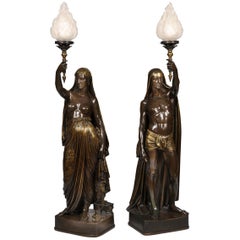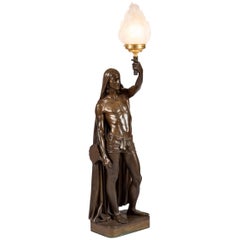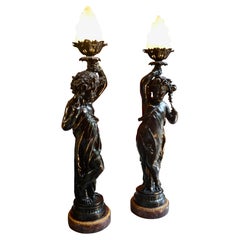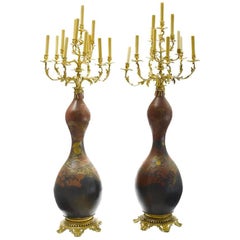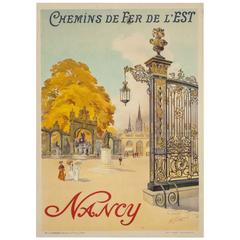A. Toussaint - G. Chaudoir Furniture
to
2
2
1
Large 19th Century Pair of Bronze Figural Torcheres
By A. Toussaint - G. Chaudoir, Ferdinand Barbedienne
Located in London, GB
A pair of Figural Porte-Lumières, cast by Barbedienne from the celebrated Armand Toussaint Models
Constructed in bronze, and having a patinated natural, and a highlighted gilt patin...
Category
Mid-19th Century French Romantic Antique A. Toussaint - G. Chaudoir Furniture
Materials
Bronze
$189,674 / set
19th Century French Bronze Lamp of Male Indian Figure
By A. Toussaint - G. Chaudoir
Located in London, GB
A well patinated bronze figure, representing an American Indian, wearing a draped headdress, robe and a pendant hooped earring. Signed to the plinth 'A.Tossaint 1850', and the foundr...
Category
19th Century French Anglo-Indian Antique A. Toussaint - G. Chaudoir Furniture
Materials
Bronze
Related Items
Matching Pair of Figural Patinated Bronze Flame Torcheres after Clodion
By Claude Michel Clodion
Located in Vancouver, British Columbia
A beautifully cast matching pair of patinated bronze figural torcheres in the manner of Clodion modeled as classically draped young girls with garlands of flowers in their hair and h...
Category
Late 19th Century French Napoleon III Antique A. Toussaint - G. Chaudoir Furniture
Materials
Bronze
Pair 19th Century Japanese Porcelain and Gilt Bronze Mounted Torchere Floor Lamp
By Imari Porcelain
Located in Los Angeles, CA
A fine pair of 19th century Japanese porcelain and French gilt bronze mounted thirteen-light celadon torchiere, floor lamp candelabra. Wired for ...
Category
19th Century Japanese Rococo Antique A. Toussaint - G. Chaudoir Furniture
Materials
Bronze
$29,850 / set
H 64.25 in Dm 25 in
Large 19th c. French Bronze Doré and Crystal 19-Light Torchieres/candelabrum
Located in Houston, TX
These Palace size French 19-light torchieres are electrified and have new wiring; this exceptional pair is a rare find with the
original gilding in beautiful condition. They are pho...
Category
Mid-19th Century French Antique A. Toussaint - G. Chaudoir Furniture
Materials
Bronze
$60,000 Sale Price / set
20% Off
H 78 in W 32 in D 32 in
A Bronze Mermaid Figural Bracket, 19th Century
Located in ARMADALE, VIC
A Bronze Mermaid Figural Bracket, 19th Century
Provenance: Private Australian Collection.
Dimension: Height: 33cm Depth: 19cm Width: 10cm.
Category
19th Century French Antique A. Toussaint - G. Chaudoir Furniture
Materials
Bronze
Large 19th Century Antique Indian Hindu Ganesha Figural Votive Brass Oil Lamp
Located in Portland, OR
A large antique early 19th century Indian brass votive oil lamp modeled as the Hindu deity, Lord Ganesha, circa 1800.
A finely cast brass figure of Lord ...
Category
Early 19th Century Indian Anglo-Indian Antique A. Toussaint - G. Chaudoir Furniture
Materials
Brass
$850
H 13.5 in W 12 in D 7 in
A Patinated Bronze Figure of Mercury, Late 19th Century
By Giambologna
Located in ARMADALE, VIC
A Patinated Bronze Figure of Mercury, Late 19th Century
Provenance: Private Australian Collection.
Description:
Modelled after Giambologna’s most celebrated work, the figure of Me...
Category
Late 19th Century Italian Antique A. Toussaint - G. Chaudoir Furniture
Materials
Bronze
Pair of 19th Century French Louis XVI Style Torchieres
Located in Houston, TX
Pair of French Louis XVI style candelabra torchieres.
Category
Late 19th Century French Louis XVI Antique A. Toussaint - G. Chaudoir Furniture
Materials
Wood
Pair of French 19th-20th Century Neoclassical Style Cast Iron Figural Torchères
Located in Los Angeles, CA
A very fine pair of French 19th-20th century neoclassical style patinated cast iron figural torchères by A. Durenne, Paris, each representing a figure of a standing young maiden, her arms raised forward while holding a a flaming urn gas light (Now electrified) with a frosted glass flame, each raised on a veined grey marble column stand, both cast-signed 'A. Durenne, Paris'. Antoine Durenne was an internationally renowned French art founder. He attended École Nationale Supérieure des Beaux-Arts in 1842. Durenne purchased a small foundry in Sommevoire, near the Val d'Osne, Haute-Marne, France and established The Durenne firm, circa Paris, 1900.
Cast-iron had been in production during the 18th century but its inferior status to the more fashionable and delicate wrought iron had generally confined its use to architectural work. By the early 19th century, however, rapid developments of the Industrial Revolution combined with the simultaneous burgeoning of a new middle class provided the impetus for a dramatic Expansion in its application and in a short space of time a proliferation of iron foundries across Europe and America thrived on the production of everything from inkstands to railway stations. The use of cast-iron for garden ornament became particularly widespread at this time, as the possibilities for its mass-production at a fraction of the cost of bronze made it the material of choice for outdoor statuary...
Category
Early 1900s French Neoclassical Revival Antique A. Toussaint - G. Chaudoir Furniture
Materials
Marble, Iron
$49,875 Sale Price / set
41% Off
H 71 in W 29 in D 27.5 in
Monumental Pair of Italian 18th Century torchère in Painted and Giltwood
Located in Round Top, TX
A truly exquisite pair of 18th century Northern Italian torchère in painted and giltwood. The shades are pierced metal and polychromed. They are lined in a white silk.
Category
Late 18th Century Antique A. Toussaint - G. Chaudoir Furniture
Materials
Wood
$15,000 / set
H 85.5 in W 20 in D 20 in
An Italian 19th Century Patinated Bronze Torchere, After Niccolò Roccatagliata
By Niccolo Roccatagliata
Located in Los Angeles, CA
A Large and Impressive Italian 19th Century Patinated Bronze Figural Torchere, after a model by Niccolò Roccatagliata (Genoa 1593 - Venice 1636). The triangular foot base with projecting putti supporting the stem and oval reserves within cartouche motifs, one containing the initials "S.D" with an olive tree in-between and a bull-head below. The stem knot with figures of winged caryatids and festoons and upper part with cherub heads, acanthus leaves and egg and bead patterns and topped with a later white glass globe. The decorative system refers to the documented artistic production of the Venetian workshop of Niccolò Roccatagliata and takes inspirational model from the base of the Renaissance bronze of the Scuola Grande di San Teodoro in Venice, a work signed by Andrea del Bartolomeo di Alessandri known as Brescianino. Electrified. Circa: Venice, 1850-1880.
RELATED LITERATURE
L. Planiscig, Venezianische Bildhauer der Renaissance, Vienna, 1921, figs. 661-664; C. Avery, 'Andrea del Bartolomeo di Alessandri detto il Bresciano" lavator di gettar di Bronzo": candelabri, satiri e battenti', M. Ceriana and V. Avery (eds.), L'Industria artistica del Bronzo del Rinascimento a venezia e nell'Italia settentrionale, Venice, 2008, pp. 233-252.
Similar models of this torchere were part of the interior decor collection at the Vanderbilt Mansion in New York (see black and white photo). The Cornelius Vanderbilt II House was a large mansion built in 1883 at 1 West 57th Street in Manhattan, New York City. It occupied the frontage along the west side of Fifth Avenue from West 57th Street up to West 58th Street at Grand Army...
Category
19th Century Italian Baroque Antique A. Toussaint - G. Chaudoir Furniture
Materials
Bronze
$14,850 Sale Price
69% Off
H 66.5 in W 19.25 in D 18 in
Gaston Leroux Bronze Figure of Aida on a Sphinx, French, 19th Century
By Gaston Vuevenot Leroux
Located in Los Angeles, CA
Gaston Leroux (French, 1854-1942). A very fine French 19th century polychromed and patinated bronze sculpture of "Aida" resting on a sphinx, her legs crossed and holding a gilt-bronze tambourine, after the model by Gaston Veuvenot Leroux "Aida, A Femme Au Tambourin Assise Sur Une Tete De Sphinx". Signed: Gaston Leroux, Paris, circa 1890.
Measures: Height 29 inches (74 cm).
Width 15 inches (38.1 cm).
Depth 15 inches (38.1 cm).
The opulent and extensively detailed version of Aida was inspired by ethnographic findings of the mid-19th century in ancient Egypt as well as the influences of theatre and costume design. Travelers to the East had often recorded their journeys, either in writing or in pictures, but the movement of Egyptomania was wider-reaching than Egyptology. The immensely popular vogue of Egyptomania is without doubt due to the success of performing arts in recreating this era, in particular, Giuseppe Verdi's Aida. Both the Cairo and Paris premieres created sensations so large that they influenced generations of artists from Alexander Cabanel to Cecil de Mille. In Aida, the ruins of Egypt were brought back to life in full color and scale before the eyes of a generation that would make history as romantics, adventurers and explorers.
The Cairo premier of Aida was entirely conceived by one of the foremost Egyptologists of the day, Auguste Mariette, who was assigned to the project by Khedive Ismail Pasha...
Category
Late 19th Century French Egyptian Revival Antique A. Toussaint - G. Chaudoir Furniture
Materials
Bronze
$26,950 Sale Price
23% Off
H 29 in W 15 in D 15 in
Spanish 18th Century Iron Torchere
Located in Round Top, TX
A wonderful primitive 18th century torchere from the Catalan region of Spain. Soundly constructed from sturdy oak and iron.
Category
18th Century Spanish Antique A. Toussaint - G. Chaudoir Furniture
Materials
Iron
Previously Available Items
Henri Toussaint Art Nouveau French Poster, circa 1907
By A. Toussaint - G. Chaudoir
Located in Dallas, TX
Henri Toussaint (French, 1849-1911).
Chemins de fer de l'est, Nancy, France, circa 1907.
Color poster.
41 x 26-1/4 inches (104.1 x 66.7 cm).
Signed in plate lower right.
This ...
Category
Early 1900s French Art Nouveau Antique A. Toussaint - G. Chaudoir Furniture
Materials
Paper
A. Toussaint - G. Chaudoir furniture for sale on 1stDibs.
A. Toussaint - G. Chaudoir furniture are available for sale on 1stDibs. These distinctive items are frequently made of metal and are designed with extraordinary care. There are many options to choose from in our collection of A. Toussaint - G. Chaudoir furniture, although gold editions of this piece are particularly popular. If you’re looking for additional options, many customers also consider furniture by Thiebaut Freres, Jean Alexandre Joseph Falguière, and Christopher Fratin. Prices for A. Toussaint - G. Chaudoir furniture can differ depending upon size, time period and other attributes — on 1stDibs, these items begin at $18,931 and can go as high as $154,843, while a piece like these, on average, fetch $86,887.
